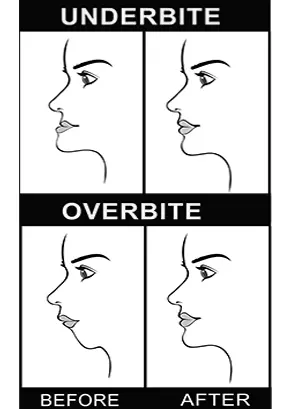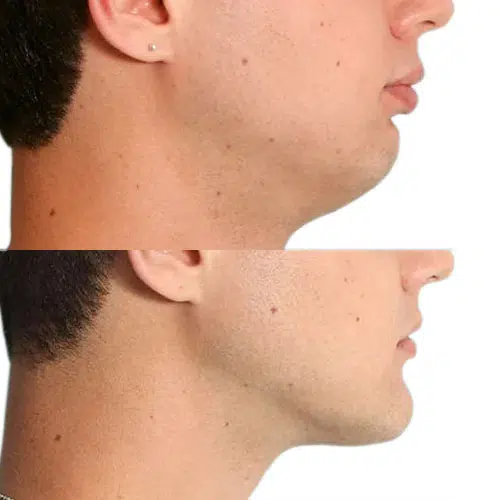Surgical Orthodontics
 Surgical orthodontics, also known as orthognathic surgery, is a type of orthodontic treatment to correct severe cases of bad bites, jaw bone abnormalities, and malocclusion. Oral and maxillofacial surgery is one of the nine recognized dental specialties that focuses on treating complex craniofacial cases involving the mouth, jaw, face, and skull.
Surgical orthodontics, also known as orthognathic surgery, is a type of orthodontic treatment to correct severe cases of bad bites, jaw bone abnormalities, and malocclusion. Oral and maxillofacial surgery is one of the nine recognized dental specialties that focuses on treating complex craniofacial cases involving the mouth, jaw, face, and skull.
If you need surgical orthodontics, your orthodontist, Dr. Gibbs, will work with an oral and maxillofacial surgeon to ensure you receive the best care possible.
What is Surgical Orthodontics? When is it Used?
When you hear the term orthodontics, your mind probably turns toward using various braces like Invisalign or fixed braces to realign teeth and create a more cosmetically perfect smile. However, while most cases of tooth misalignment can be corrected this way, some people require surgery to correct more severe issues affecting their jaws or other facial bones.
Surgery can treat cases where teeth misalignments aren’t caused by the position of the teeth of the jaws but by the size or position of the jawbones.
Surgical orthodontics, also called orthognathic surgery, uses sophisticated techniques to bring the jaws into the proper alignment so that a person can chew food properly and speak clearly.
The treatment can also help to improve their airway, allowing them to breathe more easily. Usually, orthognathic surgery is used with orthodontics.
Both orthognathic surgery and orthodontics ensure that teeth are moved into the correct positions, giving the patient an attractive and, most importantly, a healthy smile.
Jaw surgery isn’t often required, even for people with significant problems. However, orthognathic surgery can be the best way to achieve stable, long-lasting results if you have more complex issues affecting your jaws. You can rest assured your orthodontist Dr. Gibbs, will only recommend this approach if it is the best option available.
Although it may seem dramatic, surgical orthodontics is safe and effective. Corrective surgery may involve one or both jawbones.
How Can I Tell If I Need Surgical Orthodontics?

Surgical orthodontics can treat abnormalities affecting the jaws and facial bones, ensuring the jaws are aligned correctly. Misaligned jaws can create an asymmetrical facial appearance that is apparent from the front or side.
When used with conventional orthodontics like fixed braces or removable Invisalign aligners, the result is straighter teeth and, most importantly, teeth that bite together properly and are in the correct occlusion, ensuring teeth look their best and function optimally.
Surgical orthodontics could be worth investigating if you have:
- Difficulty biting
- Difficulty chewing
- Difficulty swallowing food comfortably
- Difficulty closing your lips together comfortably
- Open bite where your upper and lower teeth do not bite together fully when your mouth is closed
- Receding chin and lower jaw
- Protruding jaw
- Congenital deformities or have sustained some form of trauma or injury affecting jaw or facial bones
Surgical orthodontics can also help correct other problems, including:
- Chronic mouth breathing
- Sleep disorders like sleep apnea (airway obstruction). Moving the jaws into the proper position can help to open the airway, making it easier to breathe through the nose.
- TMJ or TMD. Many people have a problem called TMJ or TMD, a disorder that affects the jaw joints called temporomandibular joints. When teeth and jaws are misaligned, it can result in these jaw joints becoming inflamed and painful. TMD can cause chronic jaw pain, and the pain can extend into the face, neck, and shoulders and can cause headaches or migraines. TMD is often associated with other problems like teeth clenching and grinding, an issue called bruxism.
Orthognathic surgery and orthodontic treatment to realign the teeth and jaws might help correct these problems, protecting the jaw joints, relieving the unpleasant symptoms of TMJ, and protecting teeth as bruxism can be a very destructive habit.
What to Expect If You Do Need Surgical Orthodontics?
Treatment is usually a collaboration between your orthodontist, oral and maxillofacial surgeon, and possibly your general dentist.
First Phase
The first stage is thoroughly evaluating your teeth and jaws to see if this treatment is the most suitable. If your orthodontist does recommend surgical orthodontics, you will need diagnostic images that include:
- Digital dental x-rays
- Photographs
- Cone beam CT scan that produces a detailed 3-D image of your teeth and jaws
The orthodontist and surgeon may plan your treatment using these diagnostic images and virtual or plaster models of your teeth and jaws.
Usually, several months of orthodontic treatment using conventional braces is necessary before the actual surgery. Wearing braces helps realign the upper and lower teeth, preparing them for surgery. The surgical procedure is most likely performed in a hospital setting or an in-office operating suite under general anesthetic as it can take several hours to complete.
As with any form of surgery, it will take time to recover before your teeth and jaws are evaluated, usually around two weeks.
Second Phase
It may be necessary to have a second phase of orthodontic treatment at this point to ensure your realigned bite is entirely stable and to make any minor adjustments that might be required.
Braces are usually removed 6 to 12 months after surgery. Once the braces are removed, it is still necessary to wear a retainer to make sure your teeth do not shift position, which is usual with any form of orthodontic treatment.
The total treatment time can take anywhere between one and three years to complete, including orthodontic treatment before the surgery and possibly afterward.
Who Can Have Surgical Orthodontics?
Orthognathic surgery permanently changes the position of the jaws and is generally used for adults.
Orthognathic surgery isn’t suitable for children and younger teens whose jawbones and facial bones are still growing.
As a guide, girls will complete their jaw growth by age 16, whereas for boys, it is around age 18. Sometimes it may be possible to begin presurgical treatment using conventional orthodontics before jaw growth is complete and while the jaws are still growing and developing.
An orthodontist can evaluate older teens to determine when they are ready for this surgery. Although not often used, this corrective surgery can achieve many benefits, helping to provide an optimal facial appearance and oral function.
What are the risks associated with orthognathic surgery?
As with any major medical surgery, there may be certain risks of having orthognathic surgery. However, the process of orthognathic surgery is not new, and it has been performed for many years in practices and hospitals. If you’re concerned about an upcoming treatment with orthognathic surgery, please contact our practice. Our dentists are some of New York City’s best orthodontists. They are happy to answer any questions and provide you with additional information.















